Campaign Fundraising Letter
[Your Name]
[Your Address]
[City, State, ZIP Code]
[Email Address]
[Phone Number]
[Date]
[Recipient's Name]
[Recipient's Address]
[City, State, ZIP Code]
Dear [Recipient's Name],
I hope this letter finds you well. As a passionate advocate for [cause or campaign name], I am writing to share an important and exciting opportunity to make a real difference in our community and beyond.
Over the past [time period], we have witnessed [brief description of the issue/problem]. This issue affects us all, and it is time for us to come together and take action. I am committed to making a positive impact and driving meaningful change, and I invite you to join me in this endeavor.
I am reaching out to you because I believe in the power of unity and collective action. Your support can play a crucial role in our efforts to [briefly explain the goals of the campaign, such as raising awareness, advocating for policy changes, providing resources, etc.]. By contributing to this campaign, you will help us create a better future for [affected individuals, community, environment, etc.].
Here are some ways your generous donation will make a difference:
1. [Highlight a specific achievement or outcome that your campaign aims to achieve]
2. [Explain how the funds will be utilized – e.g., organizing events, creating educational materials, supporting local initiatives, etc.]
3. [Share a success story or testimonial related to your cause]
Your support matters, no matter the size of your donation. Every dollar brings us closer to our goal, and your belief in our cause inspires us to work harder and dream bigger.
To make a contribution, you can [describe how to donate – provide options such as online donation platforms, checks by mail, etc.]. Additionally, if you are unable to contribute financially at this time, your help in spreading the word about our campaign would also be greatly appreciated.
Join us in making a lasting impact. Together, we can create positive change that will resonate for generations to come. I invite you to learn more about our campaign and stay updated on our progress by visiting our website at [campaign website] or by following us on social media @[social media handles].
Thank you for taking the time to consider supporting our cause. Your involvement is invaluable, and we are truly grateful for your consideration.
With heartfelt gratitude,
[Your Name]
[Your Title or Role]
[Your Organization (if applicable)]
[Contact Information]
Initial Campaign Launch Letter
Dear [Supporter Name],
I am writing to share some exciting news: I have officially decided to run for [Position] in the upcoming [election year] election, and I hope I can count on your support.
This decision comes after months of listening to community members like you and recognizing that our [district/city/state] deserves leadership that prioritizes [key issues: education, infrastructure, healthcare, etc.]. I believe that together, we can make a real difference.
Running a successful campaign requires resources, and I am reaching out to ask if you would consider making an early contribution to help us build momentum. Your support of [suggested amount] or whatever you can afford would help us [specific use: hire staff, print materials, organize events, etc.].
Every contribution, no matter the size, brings us one step closer to victory. You can donate online at [website] or send a check made payable to [Campaign Committee Name] at [address].
Thank you for believing in this vision. I look forward to earning your support.
With gratitude,
[Candidate Name]
[Campaign Title]
Matching Gift Challenge Letter
Subject: Your donation will be DOUBLED today!
Dear [First Name],
Great news! A generous supporter has agreed to match every donation we receive between now and [deadline], dollar for dollar, up to $[amount].
This means your contribution of $50 becomes $100. Your $100 becomes $200. This is the perfect opportunity to maximize your impact on our campaign.
We're using these funds to [specific goal: reach undecided voters, launch our television ads, open field offices in key neighborhoods]. With your matched donation, we can accomplish twice as much.
Don't let this opportunity pass. Donate before [specific time/date] at [website link].
Together, we're going to win this.
[Candidate Name]
P.S. Remember, this match expires at [time] on [date]. Please act now!
Urgent Deadline Fundraising Letter
Subject: 48 hours left - we need you
[Supporter Name],
I'll be direct: we have just 48 hours until our end-of-quarter FEC deadline, and we're still $[amount] short of our goal.
This matters because our fundraising numbers will become public, and our opponents, the media, and political analysts will scrutinize them to gauge the strength of our campaign. A strong showing demonstrates momentum and viability. A weak one invites attacks and discourages future supporters.
Can you chip in $[amount] right now? Here's the link: [donation URL]
We've built something special together, but we need to prove it on paper. Your contribution before midnight on [date] will be recorded in our official FEC report.
There's no time to wait. Please donate now.
Thank you,
[Candidate Name]
Personal Story-Driven Letter
Dear Friend,
I want to tell you why I'm in this race.
When I was [age], my family faced [personal hardship: eviction, medical crisis, job loss, etc.]. I remember [specific memory that shaped values]. That experience taught me that [lesson learned], and it's why I'm committed to fighting for [policy priority].
This campaign isn't about political ambition. It's about making sure that families like mine - and maybe like yours - have someone in [office] who understands their struggles and will fight for real solutions.
But here's the reality: campaigns cost money. I'm not wealthy. I don't have corporate donors. I'm relying entirely on grassroots supporters who believe in this mission.
Would you consider donating $[amount] to help us keep this campaign going? Your contribution will fund [specific use: organizing in rural communities, training volunteers, printing voter guides].
You can donate at [website] or mail a check to [address].
Thank you for standing with me. Your support means everything.
Warmly,
[Candidate Name]
Volunteer-to-Donor Conversion Letter
Hi [Volunteer Name],
I wanted to personally thank you for [specific volunteer activity: canvassing last Saturday, making phone calls, hosting the house party]. Volunteers like you are the heart of this campaign, and I'm grateful for your time and energy.
I know you've already given so much, but I'm writing to ask if you might also consider making a financial contribution. I wouldn't ask if it weren't important.
The truth is, while volunteer power is irreplaceable, we also need resources to [print the literature you're distributing, rent the office space where you're making calls, buy the digital ads that complement your door-knocking].
If you can afford to donate $[amount] - even just $[smaller amount] - it would make a tremendous difference. Every dollar helps us reach more voters and support volunteers like you with the tools you need.
Donate here: [link]
Whether you contribute financially or not, please know how much I appreciate everything you're doing for this campaign.
With deep gratitude,
[Candidate Name]
Small-Dollar Recurring Donation Letter
Subject: Become a Campaign Sustainer - Just $[amount]/month
Dear [Supporter Name],
What if I told you that $10 a month could help change [your district/city/state]?
Most people can't write big checks to campaigns, and I don't expect them to. But small, recurring donations from people like you create a stable foundation that allows us to plan ahead, hire staff, and run the kind of campaign we need to win.
I'm inviting you to become a Campaign Sustainer by contributing just $[amount] per month through Election Day. That's less than [relatable comparison: a streaming subscription, two coffees, lunch out].
Here's what your monthly donation will do:
- $10/month = [specific impact]
- $25/month = [specific impact]
- $50/month = [specific impact]
As a sustainer, you'll receive [exclusive updates, invitation to special events, insider briefings, etc.].
Sign up for monthly donations at [website link]. You can cancel anytime, but I hope you'll stay with us through November.
Thank you for being part of this movement.
[Candidate Name]
Major Donor Solicitation Letter
Dear [Donor Name],
I'm reaching out personally because your support could be transformative for this campaign.
As you may know, I'm running for [position] because [brief compelling reason]. I've spent time reviewing FEC reports and researching what it takes to run a competitive race in this district, and the reality is clear: we need to raise $[amount] to be viable.
I'm writing to ask if you would consider joining our Leadership Circle with a contribution of $[amount - at or near legal maximum]. This level of support would allow us to [specific strategic advantages: hire a top-tier campaign manager, invest in early voter contact, secure premium ad placements].
I understand this is a significant investment, and I want you to know exactly how these funds will be deployed: [detailed budget breakdown or strategic plan].
I'd welcome the opportunity to discuss this further over [coffee/lunch/phone call]. My campaign manager, [name], will follow up to find a time that works for your schedule, or you can reach me directly at [phone/email].
Alternatively, you can donate online at [website] or mail a check to [address].
Your leadership at this critical juncture could make all the difference.
With appreciation,
[Candidate Name]
Post-Debate Fundraising Letter
Subject: Did you watch the debate last night?
[Supporter Name],
If you watched last night's debate, you saw exactly why this race matters.
My opponent [summarize opponent's weak moment or problematic position]. Meanwhile, I laid out a clear vision for [key issues]. The response has been overwhelming - our website traffic is up [X]%, and social media is buzzing.
But here's what happens next: my opponent's special interest backers will pour money into attack ads to change the narrative. We need to capitalize on this momentum NOW before they do.
Can you rush a donation of $[amount] right now while the debate is still fresh in voters' minds? We want to launch [specific campaign action: new ads highlighting the contrast, expanded canvassing operation, digital campaign] immediately.
Donate here: [link]
We have 36 hours to make the most of this moment. Let's not waste it.
Thank you,
[Candidate Name]
What Are Campaign Fundraising Letters and Why Are They Essential
Campaign fundraising letters are direct appeals for financial contributions to support political campaigns for elected office. These communications serve as the primary vehicle for candidates to build financial support from individual donors, establish relationships with supporters, and articulate their vision and needs. The purpose extends beyond mere solicitation - effective fundraising letters educate potential donors about campaign priorities, create urgency around giving, demonstrate campaign viability, and build a sense of community among supporters who share common values and goals.
Who Should Send Campaign Fundraising Letters
- The candidate personally for major donor appeals, initial campaign announcements, and highly personal or story-driven messages
- Campaign manager or finance director for operational updates, deadline reminders, and routine fundraising appeals
- Campaign finance committee as the official sender for legal compliance purposes
- Prominent endorsers or surrogates (elected officials, community leaders, celebrities) to reach new audiences and lend credibility
- Campaign chair or co-chairs for leadership circle invitations and high-dollar solicitations
- Volunteer coordinators when converting volunteers to financial donors
Elements and Structure Every Fundraising Letter Must Include
- Compelling subject line (for emails) that creates urgency or interest without being misleading
- Personal greeting using the recipient's name when possible
- Hook or opening that immediately captures attention and establishes why this message matters
- Clear statement of what you're asking for - never bury the actual request
- Specific dollar amount suggestions to guide donor decision-making
- Concrete explanation of how funds will be used
- Deadline or urgency factor when applicable (FEC reporting, matching gift expiration, etc.)
- Multiple giving options including online link, mail-in address, and sometimes phone number
- Gratitude and acknowledgment of the recipient's previous support if applicable
- Strong closing that reinforces the ask and creates emotional connection
- Legal disclaimer including "Paid for by [Committee Name]" as required by election law
- Compliance statement about contribution limits if soliciting major gifts
When to Send Campaign Fundraising Letters
- Campaign launch to announce candidacy and begin building war chest
- Before FEC quarterly deadlines (March 31, June 30, September 30, December 31) when reports become public
- After major campaign events like debates, endorsements, or media coverage to capitalize on momentum
- During matching gift periods when donors have offered to match contributions
- At critical campaign milestones such as reaching petition signature requirements or ballot qualification
- Following attacks from opponents to demonstrate supporter solidarity and raise rapid response funds
- End-of-year giving season (November-December) when donors are thinking about tax-deductible contributions
- Final weeks before election for get-out-the-vote funding needs
- After volunteer activities to convert active supporters into financial contributors
- During slow fundraising periods to maintain consistent cash flow
How to Write and Send Effective Campaign Fundraising Letters
- Segment your audience - create different messages for major donors, small-dollar contributors, volunteers, and new prospects
- Research your recipients to personalize asks appropriately based on giving history and capacity
- Lead with emotion or story before diving into the technical details or policy positions
- Use specific numbers for both ask amounts and impact descriptions ("$50 reaches 200 voters")
- Create authentic urgency based on real deadlines, not manufactured crises
- Test subject lines and messaging through A/B testing with small samples before sending to full list
- Choose appropriate channels - email for frequent small-dollar appeals, postal mail for major donor cultivation
- Time sends strategically based on recipient behavior data (evening for working professionals, mid-morning for retirees)
- Include social proof mentioning momentum, number of contributors, or notable endorsers
- Make giving easy with one-click donation links and pre-filled amounts
- Follow data privacy laws and honor unsubscribe requests immediately
Formatting Guidelines for Campaign Fundraising Letters
- Length: Email appeals should be 200-400 words for broad audiences, longer (600-800 words) for engaged supporters or major donors; postal letters can extend to two pages for high-dollar solicitations
- Tone: Professional yet conversational; urgent but not desperate; confident without arrogance
- Readability: Short paragraphs (2-3 sentences), bullet points for impact lists, bold text sparingly for emphasis
- Mobile optimization: 60% of political emails are opened on mobile devices - ensure formatting works on small screens
- Signature: Blue ink signature image for emails, actual signature for postal letters
- Font and design: Clean, readable fonts; campaign brand colors; minimal graphics that don't distract from message
- Call-to-action buttons: Prominent, action-oriented ("Donate Now," "Chip In $25," "Join Our Team")
- Personalization: Use merge fields for names, previous giving amounts, and location-specific references
Mistakes to Avoid in Campaign Fundraising Letters
- Asking without explaining impact - donors need to understand what their money accomplishes
- Being vague about amounts needed - "anything helps" is less effective than specific dollar suggestions
- Overusing crisis language - if every appeal is "urgent" or "critical," none of them are
- Forgetting to thank previous donors before asking again
- Making the donation process complicated with broken links or too many steps
- Sending too frequently and causing donor fatigue (more than 2-3 emails per week is typically excessive)
- Ignoring legal requirements like contribution limits, disclaimer language, and prohibited sources
- Using misleading subject lines that damage trust when opened
- Neglecting to segment audiences and sending identical messages to small donors and major contributors
- Focusing only on winning rather than values and vision - donors support causes, not just victories
- Poor proofreading that undermines professionalism
- Sending at wrong times like major holidays or during competing news cycles
Requirements and Prerequisites Before Sending Fundraising Letters
- Campaign committee registration with FEC (federal races) or state/local election board
- Dedicated campaign bank account separate from personal finances
- Federal/state contribution limits research to ensure compliance
- Fundraising database or CRM system to track donors, contributions, and communication history
- Email service provider with political campaign experience and compliance features
- Legal review of disclaimer language and solicitation practices
- Donor list development including past supporters, volunteers, and prospect research
- Campaign budget and fundraising goals to guide ask amounts and allocation explanations
- Compelling case for support articulated clearly in campaign messaging
- Online donation infrastructure with secure payment processing
- Staff or volunteers designated for donor acknowledgment and gift processing
After Sending: Follow-Up and Stewardship Actions
- Send immediate automated thank-you when donations are received online
- Personal thank-you within 48 hours via email or phone for donations above certain threshold
- Handwritten notes for major donors ($500+) from the candidate personally
- Issue tax receipts if applicable and legally required
- Update donor database with contribution details and interaction notes
- Monitor response rates and analyze which messages performed best
- Track toward fundraising goals and adjust strategy if response is below projections
- Provide impact updates showing donors how their money is being used
- Invite donors to events appropriate to their giving level
- Continue cultivation even after donation with non-fundraising updates and engagement opportunities
- Re-engage non-responders with different messaging after appropriate waiting period (2-4 weeks)
- Segment based on response to tailor future communications
Tips and Best Practices for Maximum Fundraising Success
- The 48-hour rule: Contact donors within two days of their contribution to maximize likelihood of future giving
- Use P.S. strategically: Most readers scan to the postscript - use it to reinforce urgency or add compelling detail
- Name-drop strategically: Mention respected endorsers or supporters to build credibility
- Show momentum: "We've received 247 donations in the last 24 hours" creates bandwagon effect
- Offer naming opportunities: "Sponsor a canvass shift for $100" gives tangible connection
- Create artificial scarcity: "We can only fund three more field offices" (when true)
- Use social proof: Include testimonials from other donors about why they gave
- Test everything: Subject lines, send times, ask amounts, message framing
- The "ladder of engagement": Move people from small asks to larger ones over time
- Make donors feel special: Exclusive updates, early announcements, behind-the-scenes access
- Video integration: Include links to candidate video messages in letters for stronger emotional connection
Comparing Campaign Fundraising Letters to Alternative Fundraising Methods
Fundraising Letters vs. Fundraising Events: Letters scale infinitely with minimal incremental cost, while events have capacity limits but create stronger personal connections and can generate larger individual contributions. Letters work continuously; events require intensive planning and staff time.
Email vs. Postal Mail: Email delivers instantly at near-zero cost and allows rapid response, ideal for urgent appeals and frequent communication with small-dollar donors. Postal mail costs $0.50-2.00 per piece but stands out in less-crowded mailboxes, appropriate for major donor cultivation and older demographics.
Direct Solicitation vs. Peer-to-Peer Fundraising: Traditional letters come from campaign directly, while peer-to-peer empowers supporters to fundraise within their networks. Peer-to-peer expands reach but requires training and yields less control over messaging.
Broad Appeals vs. Personal Asks: Mass letters reach thousands but convert at lower rates (1-5%). Personal phone calls or in-person asks to qualified prospects convert at 30-50% but require significant time investment per donor.
Advantages and Disadvantages of Campaign Fundraising Letters
Advantages:
- Scalability: Reach thousands of potential donors with single effort
- Cost-effectiveness: Especially email, with minimal marginal cost per recipient
- Documentation: Creates written record of campaign activities and donor interactions
- Testing capabilities: Easy to experiment with different messaging approaches
- Recurring revenue potential: Can establish monthly giving programs
- Time efficiency: Allows candidate to focus on other campaign activities while fundraising continues
- Geographic reach: Solicit support beyond immediate community
Disadvantages:
- Lower response rates: Typically 1-5% for cold outreach, even less for some audiences
- Donor fatigue risk: Over-solicitation damages relationships and future giving potential
- Limited personalization at scale: Mass communications lack intimacy of personal asks
- Deliverability challenges: Email spam filters, postal delivery issues
- Compliance complexity: Must navigate campaign finance laws carefully
- Competition: Donors receive solicitations from multiple campaigns and causes
- Impersonal perception: Can seem transactional rather than relationship-building
Frequently Asked Questions About Campaign Fundraising Letters
How many fundraising letters should a campaign send? Depends on office level and list size, but typical range is 2-4 emails per week to core supporters, with reduced frequency for casual supporters. Postal mail typically 3-6 pieces throughout campaign cycle.
Can campaigns accept anonymous donations? No for amounts over $50 (federal). All contributions exceeding threshold require donor identification including name, address, occupation, and employer.
What's a good response rate for fundraising emails? Open rates of 20-30%, click-through rates of 2-5%, and conversion rates of 0.5-2% are typical. Rates vary significantly based on list quality and engagement level.
Should candidates ever use humor in fundraising letters? Humor can work for certain brands and audiences, but use cautiously - fundraising is serious business. Self-deprecating humor is safer than sarcasm or jokes about opponents.
How do you fundraise without seeming desperate? Project confidence in your campaign and cause while being honest about resource needs. Frame asks around opportunity and impact rather than survival.
Can campaigns email anyone? No - you need implied or explicit consent. Existing supporters, volunteers, and those who've engaged with campaign are appropriate. Purchasing random email lists typically violates anti-spam laws.
What's the optimal number of ask amounts to suggest? Three to five options works well: low entry point, middle "recommended" amount (often highlighted), and aspirational higher amount. Base on donor history when possible.
Should fundraising letters discuss opponents? Contrast is effective when tied to values and vision, but avoid purely negative attacks. Focus on why you're the better choice, not just why opponent is wrong choice.

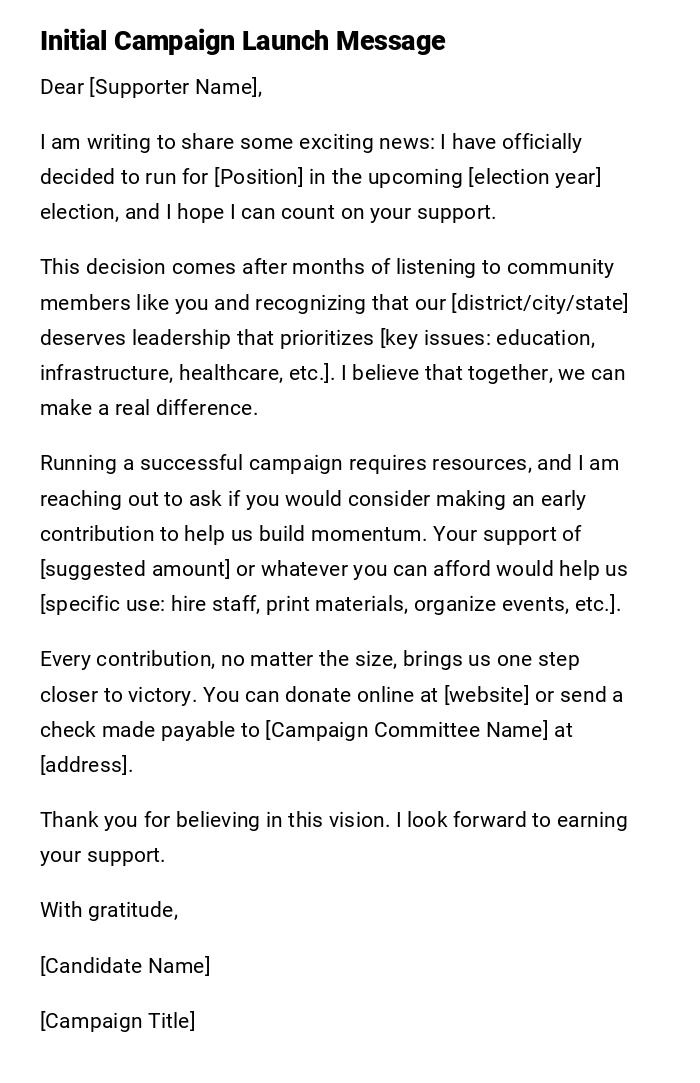
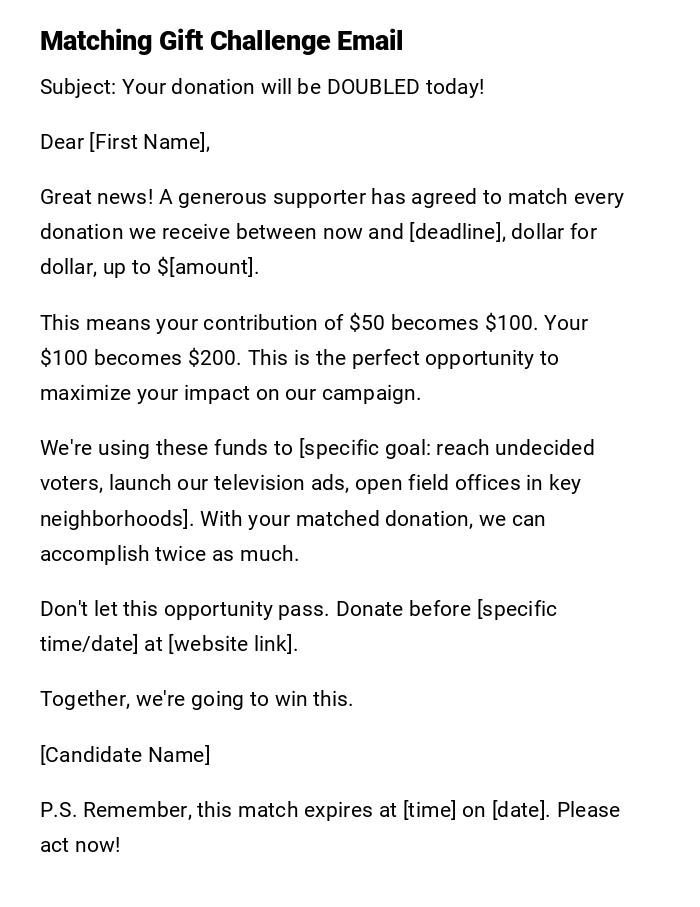
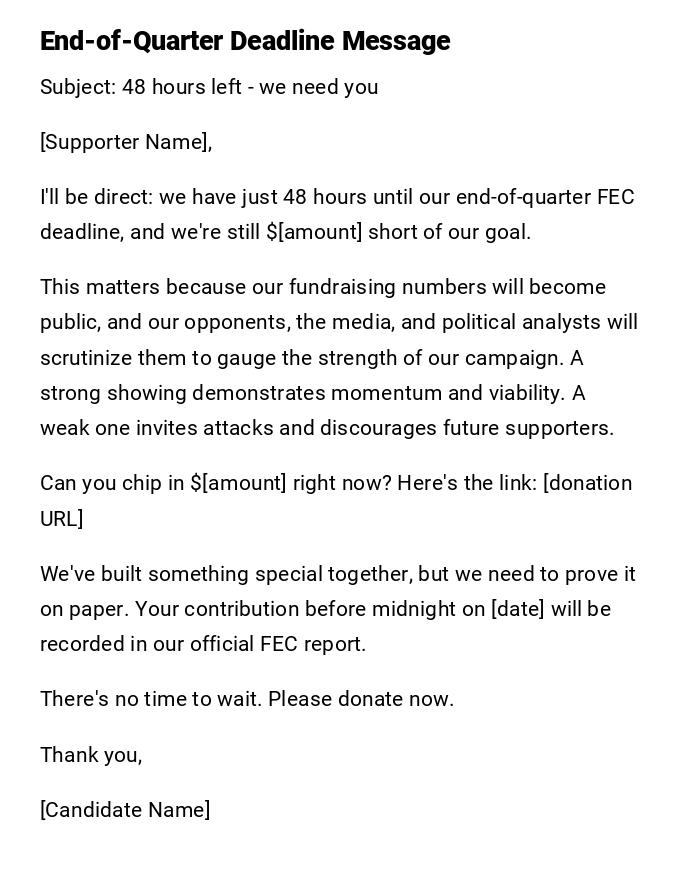
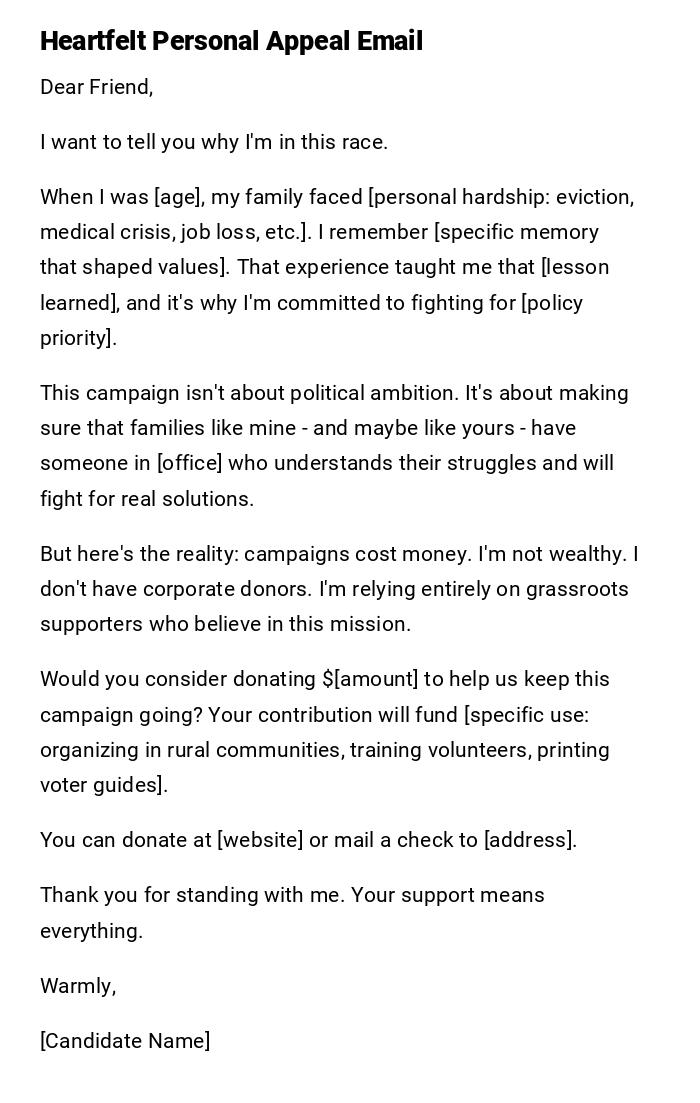
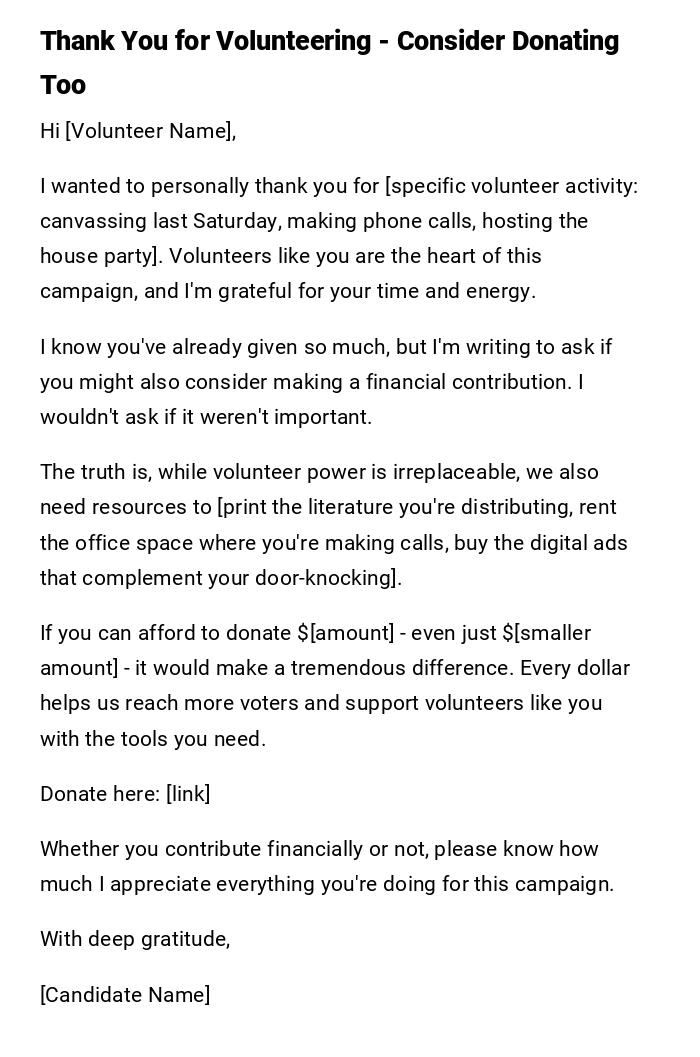
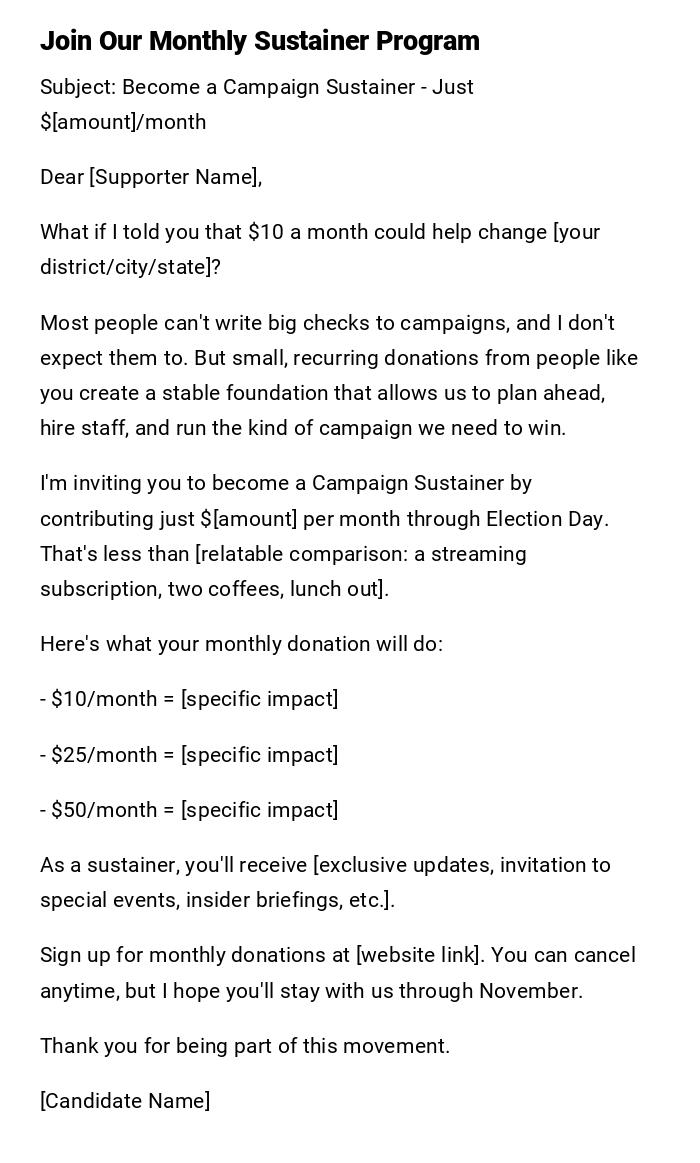
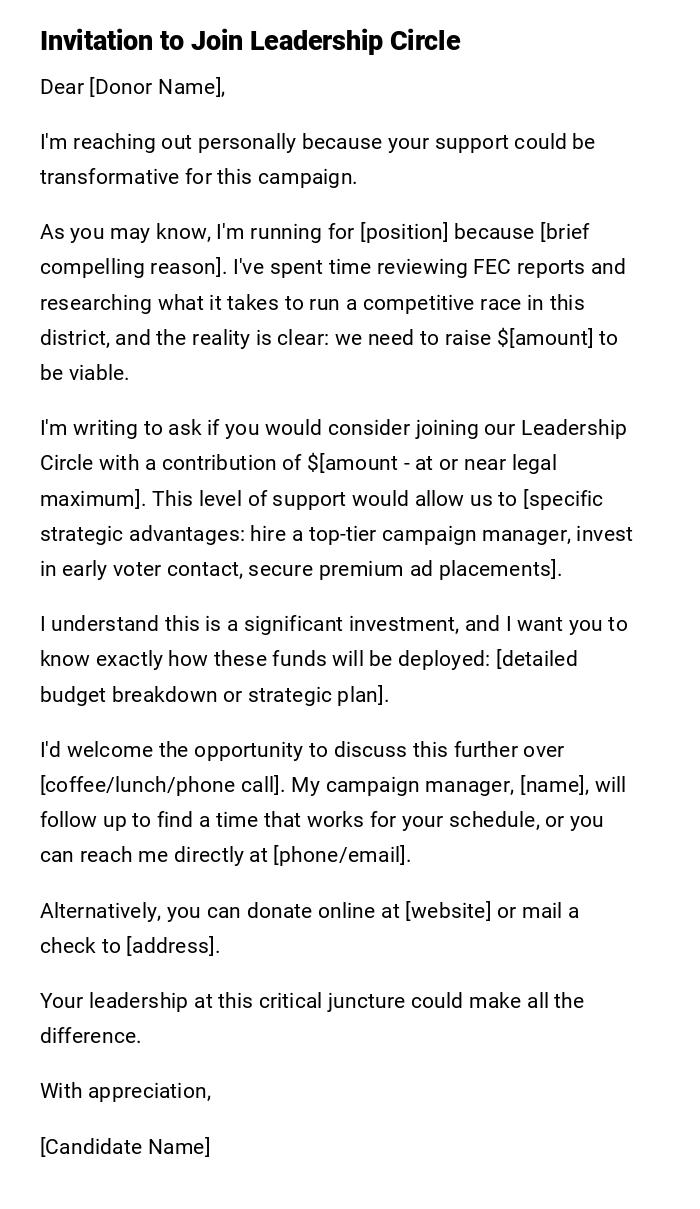
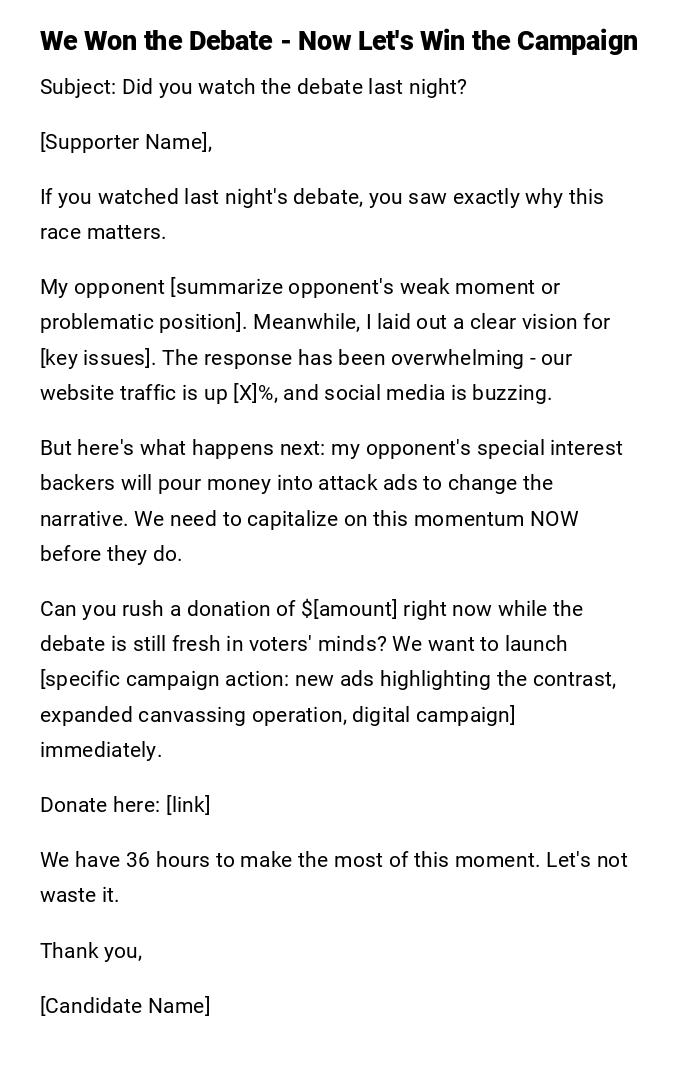

 Download Word Doc
Download Word Doc
 Download PDF
Download PDF